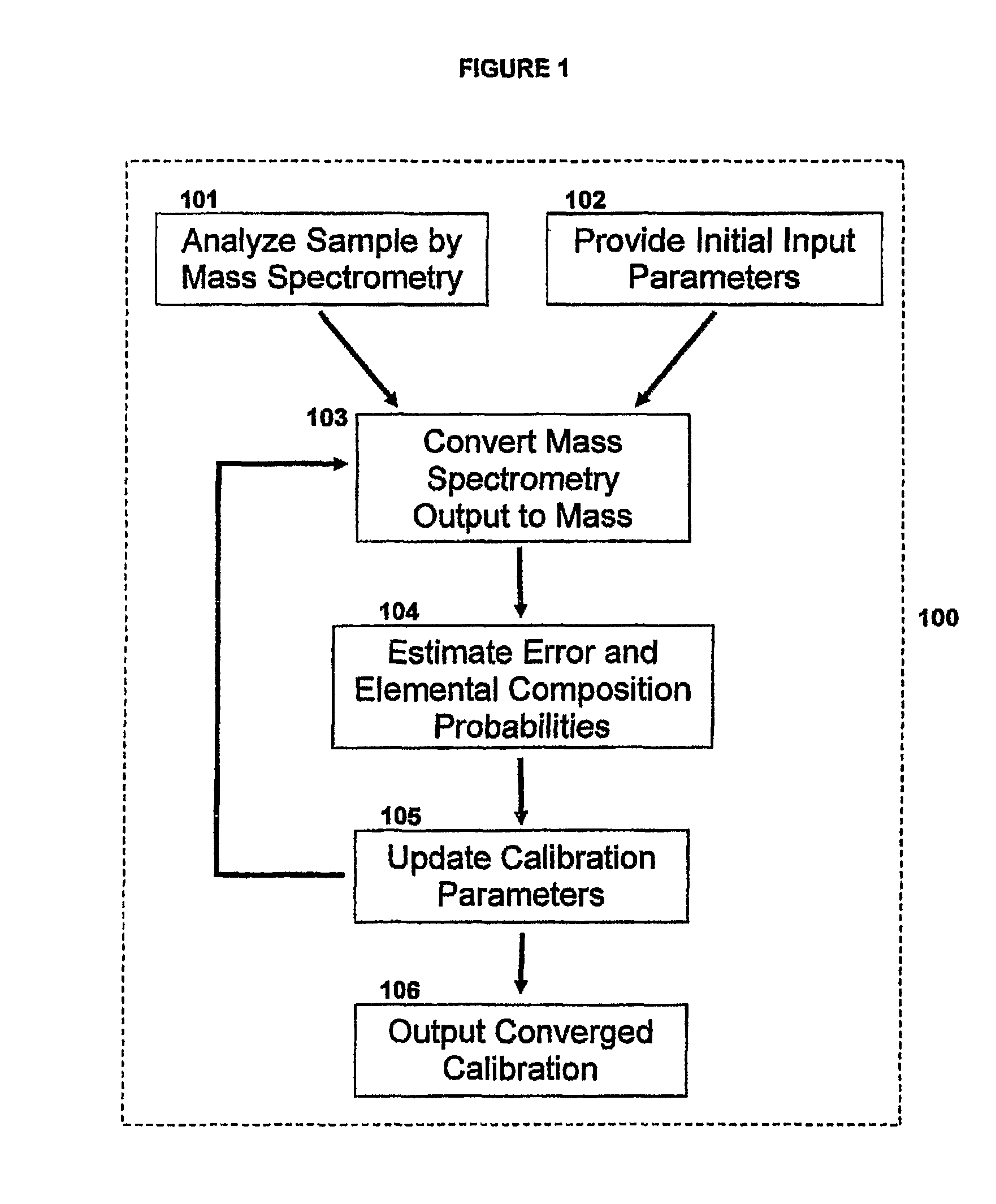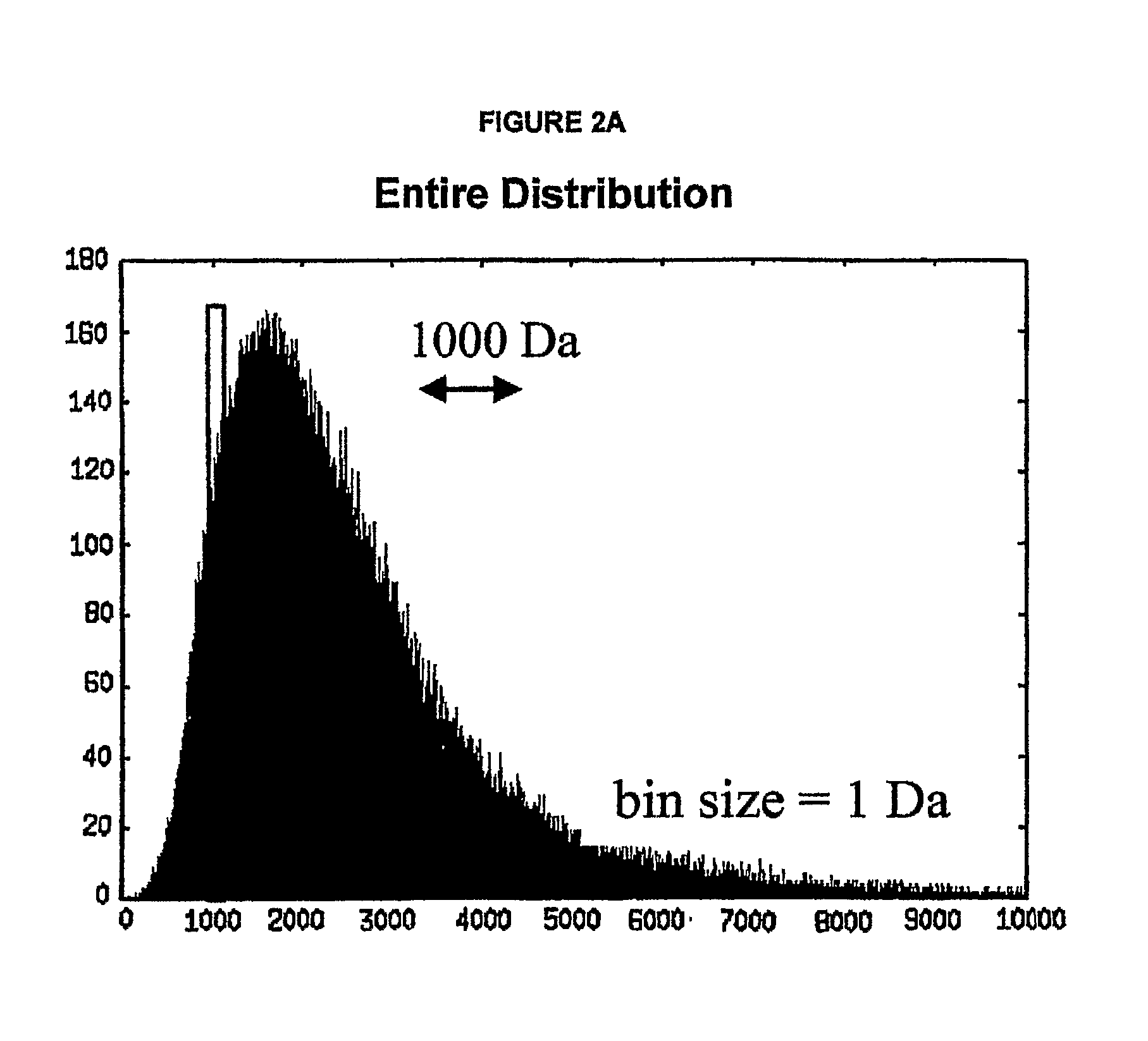Method for simultaneous calibration of mass spectra and identification of peptides in proteomic analysis
a mass spectra and proteomic analysis technology, applied in the direction of calibration apparatus, instruments, separation processes, etc., can solve the problems of inability to use high-mass-accuracy systems such as ftms, the most difficult control and model of the space-charge effect, and the inability to maintain the calibration parameters constan
- Summary
- Abstract
- Description
- Claims
- Application Information
AI Technical Summary
Problems solved by technology
Method used
Image
Examples
example 1
Assessment of a Peptide's Exact Mass from a Mass Measurement with Known Error
[0066]In this Example, the mass of a peptide is measured, and the measured mass is denoted as β. To make an inference about the true mass of the peptide from the measured value, a quantitative model of the measurement process is needed. The measurement of a peptide with mass a can be modeled as the sum of the true mass α plus an error term, e.
[0067]The error term, denoted by “e”, is a normally distributed random variable with mean zero and variance σ2. The conditional probability density, p(β|α), evaluated at β is given below.
[0068]p(β|α)=(2πσ2)-1 / 2exp(-(β-α)22σ2)(1)
[0069]For the purposes of this example, a database of all possible exact mass values may be provided, and the set of these values may be denoted by {α1, α2 . . . αr}. Peptide exact mass assessment involves assigning probabilities to the possible mass values, p(αj|β), j [1 . . . r], given the measured value β. These probabilities may be compu...
example 2
Estimation of Mass Measurement Error Variance from Measurements of Known Peptides
[0073]A related calculation is the estimation of the variance of the mass measurement error e from a collection of measurements of peptides of known masses. For example, in this case, one may have q peptides with masses αm(1), αm(2), . . . αm(q) respectively. Each peptide in sequence may be measured resulting in measured values β1, β2, . . . βq respectively. That is, for each i from 1 to q, βi is the measured value of the ith peptide, whose true mass is αm(i).
[0074]If it is known that when measurement errors are independent and identically distributed normal random variables with mean zero, the maximum likelihood estimate of the variance of the error may be computed. Let σ2 denote the (unknown) variance of the error. The probability density for the measured value of a peptide with mass αm(i), evaluated at the value β1 is given by Equation 1.
[0075]Let N-component vectors α and β denote the ordered collec...
example 3
Estimation of Measurement Error from Measurements of Unidentified Peptides
[0087]In the previous two examples, it was demonstrated 1) how to assess a peptide's exact mass from a mass measurement when the measurement error is known and 2) how to estimate the measurement error from a collection of known peptides. In this Example, the maximum likelihood estimate of the normalized measurement error variance from measurements of unidentified peptides will be derived. This solution will be interpreted in terms of the solutions of the problems in Examples 1 and 2.
[0088]In this Example, one has a database of all possible exact mass values denoted by a=(α1, α2, . . . αr) and a collection of mutually independently measured peptide masses b=(β1, β2, . . . βq). There exists a mapping m: [1 . . . q]→[1 . . . r] such that for each i in [1 . . . q], measured value βi resulted from measuring a peptide with mass αm(i). If this mapping were known, it would be possible to estimate the normalized error ...
PUM
 Login to View More
Login to View More Abstract
Description
Claims
Application Information
 Login to View More
Login to View More - R&D
- Intellectual Property
- Life Sciences
- Materials
- Tech Scout
- Unparalleled Data Quality
- Higher Quality Content
- 60% Fewer Hallucinations
Browse by: Latest US Patents, China's latest patents, Technical Efficacy Thesaurus, Application Domain, Technology Topic, Popular Technical Reports.
© 2025 PatSnap. All rights reserved.Legal|Privacy policy|Modern Slavery Act Transparency Statement|Sitemap|About US| Contact US: help@patsnap.com



